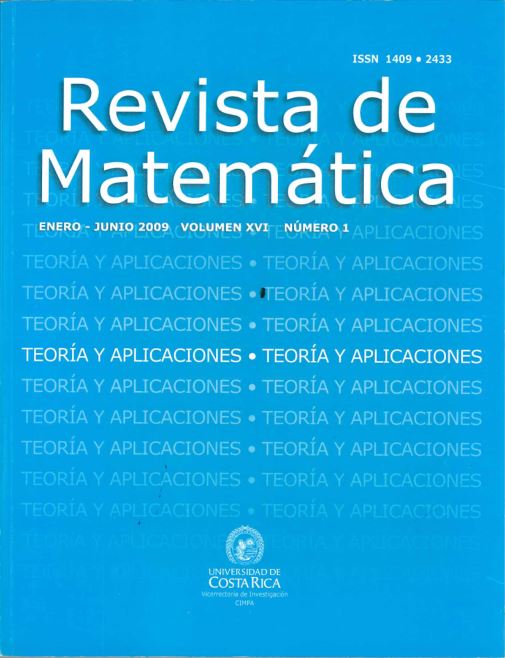Abstract
Two methods for filling missing data gaps in geophysical time series are presented. The first one is based on the principal component decomposition of the correlation matrix built for close spatial stations with common time series records of the same variable. This multivariate method allows the incorporation in the estimated values of large scale features based on the information shared by the stations. The second method could be used when there are no close station and the missing data must be calculated from the same station historical information. This method adjusts an auto-regressive model to the time series which is then used to estimate the missing data. Two algorithms were used to calculate the auto-regressive coefficients: the Burg estimator and the one proposed by Ulrych and Clayton. The first one is appropriate for stochastic processes and the second for deterministic series. The two methodologies described in this work are recursive: a first estimation of the missing data is done running the algorithms but ignoring or using a crude approximation of them. Then, the algorithm runs again with the new estimated data, replacing the previous run missing data estimations. The run stops when the maximum difference between two successive estimations is smaller than the value fixed by the user. Filled data conserves the mean and standard deviation of the original time series. These algorithms have been adapted and modified for its use in SCILAB using also Graphic User Interfaces. Scilab is an open source platform, similar to MATLAB, and runs indistinctively in Windows and Linux. They were elaborated as an extension activity of the University of Costa Rica.
References
Alfaro, E.; Cid, L. (1999) “Ajuste de un modelo VARMA para los campos de anomalías de precipitación en Centroamérica y los índices de los océanos Pacífico y Atlántico Tropical”, Atmósfera, 12(4): 205–222.
Ebisuzaki, W. (1997) “A method to estimate the statistical significance of a correlation when the data are serially correlated”, J. Climate 10: 2147–2153.
Kay, S.M.; Marple, S.L. (1981) “Spectrum analysis – A modern perspective”, Proc. IEEE, 69: 1380–1419.
Magaña, V.; Amador, J.; Medina, S. (1999) “The midsummer drougth over Mexico and Central America”, Journal of Climate 12: 1577-1588.
North, G.R.; Bell, T.L.; Cahalan, R.F.; Moeng, F.J. (1982) “Sampling errors in the estimation of empirical orthogonal functions”, Mon. Wea. Rev. 110: 699–706.
Press, W.H.; Teukolsky, S.A.; Vetterling, W.A.; Flannery, B.P. (1992) Numerical Recipes in C: the Art of Scientific Computing. Cambridge University Press, Cambridge.
Sciremammano, F. (1979) “A suggestion for the presentation of correlations and their significance levels”, J. Phys. Oceanogr. 9: 1273–1276.
Soley, F.J. (2003) Análisis en Componentes Principales. Notas de clase del curso SP-5906, Métodos Digitales de Análisis de Secuencias Temporales. Programa de Posgrado en Ciencias de la Atmósfera. Sistema de Estudios de Posgrado Universidad de Costa Rica (Accesible en http://fjsoley.com).
Soley, F.J. (2005) Sistemas lineales ARMM(p,q) con p + q ≤ 4. Primera Parte: Sistemas lineales AR (p ≤ 4). Notas de clase del curso SP-5906, Métodos Digitales de Análisis de Secuencias Temporales. Programa de Posgrado en Ciencias de la Atmósfera. Sistema de Estudios de Posgrado. Universidad de Costa Rica (Accesible en http://fjsoley.com).
Soley, F.J.; Alfaro, E. (1999) “Aplicación de análisis multivariado al campo de anomalías de precipitación en Centroamérica”, Tóp. Meteor. Oceanog. 6(2): 71–93.
Tabony, R.C. (1983) “The Estimation of Missing Climatological Data”, Journal of Climatology 3: 297–314.
Ulrych T.J.; Bishop, T.N. (1975) “Maximum Spectral Analysis and Autoregressive Decomposition”, Reviews of Geophysics and Space Physics 13(1): 183–200.
Ulrych T.J.; Clayton, R.W. (1976) “Time Series Modeling and Maximum Entropy”, Physics of the Earth and Planetary Interiors 12: 188–200.
Wilks, D. (1995) Statistical Methods in the Atmospheric Sciences. Academic Press, New York.
